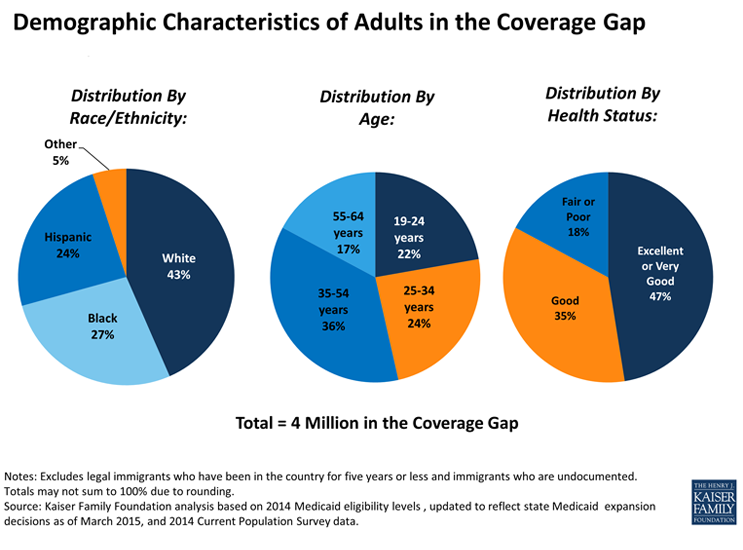The Present and Future Uninsured.
 I have often commented that public health ultimately aspires to create the conditions that make people healthy. While in many respects medical care then falls outside the remit of public health, it is clear that the provision of health coverage—ensuring that as many people as possible have access to health care when they need it—is indeed one of the conditions that contributes to the production of health, and as such is worth public health attention. The topic of health coverage has dominated much of the health discussion in this country over the past six years as the (ACA) became law and the subject of several court battles thereafter. The ACA refers to two legislations: the Patient Protection and Affordable Care Act and the Health Care and Education Reconciliation Act. Together, the core components of these laws include the expansion of Medicaid, the ability for people under the age of 26 to remain on their parents’ insurance, the elimination of denied coverage for pre-existing conditions, and the availability of affordable insurance through Health Insurance Marketplaces. The Supreme Court limited the law expanding Medicaid in 2012 by striking down Congress’s decision to enforce the expansion program in all states and allowing the states to opt out if they so chose. Currently, there are 19 states not adopting the Medicaid expansion and 1 state where the adoption is under discussion. The remaining states, including DC, have adopted the expansion. Following months of deliberations, the Supreme Court recently upheld a key component of the ACA that provides health insurance subsidies to all qualifying Americans, ensuring the continuation of the ACA as it is currently being implemented.
I have often commented that public health ultimately aspires to create the conditions that make people healthy. While in many respects medical care then falls outside the remit of public health, it is clear that the provision of health coverage—ensuring that as many people as possible have access to health care when they need it—is indeed one of the conditions that contributes to the production of health, and as such is worth public health attention. The topic of health coverage has dominated much of the health discussion in this country over the past six years as the (ACA) became law and the subject of several court battles thereafter. The ACA refers to two legislations: the Patient Protection and Affordable Care Act and the Health Care and Education Reconciliation Act. Together, the core components of these laws include the expansion of Medicaid, the ability for people under the age of 26 to remain on their parents’ insurance, the elimination of denied coverage for pre-existing conditions, and the availability of affordable insurance through Health Insurance Marketplaces. The Supreme Court limited the law expanding Medicaid in 2012 by striking down Congress’s decision to enforce the expansion program in all states and allowing the states to opt out if they so chose. Currently, there are 19 states not adopting the Medicaid expansion and 1 state where the adoption is under discussion. The remaining states, including DC, have adopted the expansion. Following months of deliberations, the Supreme Court recently upheld a key component of the ACA that provides health insurance subsidies to all qualifying Americans, ensuring the continuation of the ACA as it is currently being implemented.
The development of a health insurance system in the US can be traced back to the 1930s with the establishment of nonprofit Blue Cross plans for hospital care, followed by Blue Shield plans for physician care. Following the Second World War, a number of commercial (i.e. for-profit) insurers began to compete with Blue Cross and Blue Shield, leading to a dramatic growth in health insurance coverage. The introduction of Medicaid and Medicare in 1965 further expanded the coverage. Medicare is for people over the age of 65, certain younger populations, and those diagnosed with end-stage renal failure. The original Medicaid program is jointly funded by the states and the federal government and is designed to service those with low income, pregnant women, children, elderly people, and people with disabilities.
The US system of health insurance coverage is of course challenged by our absence of a single payer health system, as is the case with peer countries like Canada and the UK. Therefore, the ACA aims to “fill in the gaps”—to ensure that no American falls through the cracks of coverage between multiple different insurance providers. At core, the ACA aims to expand coverage for the lowest-income Americans (adults with incomes up to 133 percent of the federal poverty level and below the age of 65) by providing an opportunity for states to expand the eligibility of Medicaid.
在
Th

The coverage gap in states that did not expand Medicaid.
罗
The ACA clearly represents an enormous triumph of social legislation, improving access of millions to health insurance, and better health coverage, in a relatively short period of time. The remaining uninsured represent an ongoing challenge, and in many ways are a reflection of a patchy system that is only imperfectly addressed via the ACA, particularly in the face of state-level intransigence. Public health stands to play a central role in coming years to ensure that limited access does not disproportionately affect marginalized groups who are already subject to substantial health burdens.
I hope everyone has a terrific week. Until next week.
Warm regards,
Sandro
Sandro Galea, MD, DrPH
Dean and Professor, Boston University School of Public Health
Twitter: @sandrogalea
Acknowledgement: I am grateful for the contributions of Laura Sampson and Salma Abdalla MBBS to this Dean’s Note.
Previous Dean’s Notes are archived at: /sph/category/news/deans-notes/